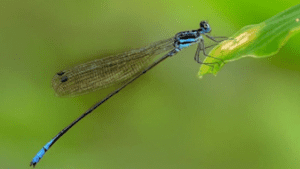TAG: GS 3: ECOLOGY AND ENVIRONMENT
THE CONTEXT: In a significant breakthrough, a team of researchers has unearthed a new species of damselfly in the Ponmudi hills of Thiruvananthapuram district, Kerala.
EXPLANATION:
- The discovery is particularly noteworthy as it challenges the long-standing belief that the genus Phylloneura was monotypic, with only one described species for over 160 years.
- The findings have been published in the International Journal of Odonatology.
Cliffside Bambootail (Phylloneura rupestris):

- The damselfly belongs to the bambootails group, named for their elongated abdomen resembling bamboo stalks.
- Unlike the previously known Myristica Bambootail, this new species lays its eggs in moss beds found in seasonal rills flowing over rock cliffs.
- This distinct behaviour sets Cliffside Bambootail apart, as opposed to the Myristica Bambootail, which lays eggs on the surface roots of riparian trees.
- The Ponmudi hills, situated at the southernmost tip of the Western Ghats in the Agasthyamalai landscape, have proven to be a hotspot for biodiversity.
- This discovery marks the third damselfly species identified in this region, emphasizing its ecological richness.
- For more than 160 years, the genus Phylloneura was considered monotypic, with the Myristica Bambootail being the sole described species.
- The discovery of Cliffside Bambootail challenges this notion, showcasing the diversity within the genus.
- The contrasting egg-laying behaviour of Cliffside Bambootail, choosing moss beds in seasonal rills, distinguishes it from the Myristica Bambootail.
- Understanding such behavioural nuances is crucial for comprehending the ecological roles and adaptations of damselfly species.
Conservation Implications:
- The Myristica Bambootail, endemic to the Western Ghats, was considered near-threatened.
- The discovery of a new species emphasizes the need for comprehensive studies to safeguard the biodiversity of the southern Western Ghats.
Conclusion:
- The identification of Cliffside Bambootail expands our understanding of damselfly diversity in the Western Ghats and calls for increased conservation efforts. This discovery underscores the importance of continuous research to unravel the complexities of biodiversity and ecological interactions in specific regions, contributing to effective conservation strategies.

